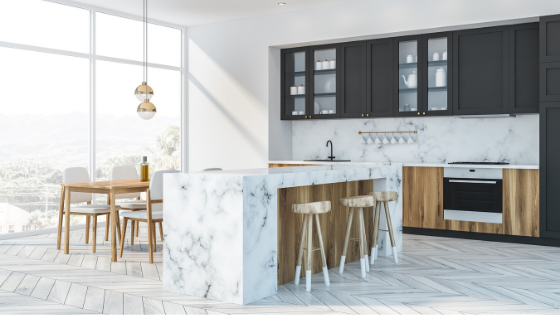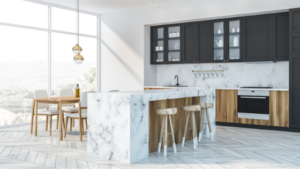Marble is a soft, calcium-based stone that can be cut into slabs and tiles to adorn the inside and outside of your home. Many homeowners adore using marble for their countertop surfaces because it’s sturdy and durable. Although this stone is a beautiful option that will accentuate your countertops, it can also be high maintenance if you don’t stay on top of your cleaning routine. Continue reading to find out how to seal your marble countertops.
Why Do I Need to Seal My Marble Countertops?
As a marble countertop owner, you must seal them regularly so they last for decades to come. Marble is a porous surface, meaning it will absorb impurities from water and other liquids that come in contact with it. When you seal your countertops, you’re ensuring they won’t be stained by liquids.
If you were to put most countertops under a microscope, you’d notice they have tons of microscopic pores. These pores aren’t a bad thing, and they’re the result of stone formation. Whether your surfaces were made by someone who compacted small grains of organic matter, or through recrystallizing under intense heat and pressure, pores are formed by the tiny gaps left between individual grains or crystals.
Don’t let the porosity of this stone keep you from showing off your marble countertops because the sealing process becomes easy once you do it a few times. Moreover, every stone countertop requires sealing, so this process isn’t exclusive to marble.
How Do I Seal My Marble Countertops?
Once you learn how to seal your countertops, it’ll become second nature. Before you can do this, you’ll need:
- Marble cleaner
- Several soft cloths
- Marble sealer
- Open-mouthed container
- Foam paintbrush
Once you’ve gathered your materials, follow this step-by-step guide:
Step 1: Spray your surfaces with a marble cleaner and buff them dry with a soft cloth; this will remove all impurities that would otherwise interfere with the sealing process.
Step 2: Pour marble sealer into your open-mouthed container. Make sure your container is wide enough to dip your paintbrush into. Turn on a fan or open your windows when you’re doing this step because marble sealers have a high amount of volatile organic compounds. These compounds are emitted as gases from certain solids or liquids, and they include a variety of chemicals which can leave you with long-term health effects. Keep the sealer away from children.
Step 3: Dip your paintbrush into your sealer and paint it onto your surfaces using overlapping strokes. Paint over all of the areas, including the edges, areas around the sink, and the backsplash. Let the sealer sit for ten minutes.
Step 4: Buff away the excess sealer with your cloths using circular motions. Continue buffing until the sealer is completely removed; otherwise, it will mar the finish of the stone.
Contact Intermountain Stone & Marble
Although marble countertops are long-lasting, at some point you may need a replacement if yours are decades old. Intermountain Stone & Marble is a full-service custom stone fabricator that specializes in marble countertops. Contact us today for your free estimate.


